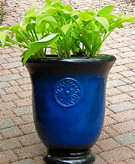Slugs are a common pest in many gardens and are the most common cause of hosta leaves that are covered with holes. This damage is especially visible late in the season because the holes accumulate over time, giving an almost lacy effect to the most severely damaged leaves. But you don't have to have holey hostas!
The perpetrator of perforated hosta leaves is the common garden slug, usually the Gray Garden Slug in this part of Michigan. A slug has a lifespan of from 9-13 months, and can overwinter as an adult. The slug usually lays 20-30 eggs at a time, several times per season. The eggs can also overwinter. An egg hatches in about 3 weeks under the right conditions. So, there are always plenty of slug eggs in the soil, available to hatch all season long.
There are three basic approaches to controlling slugs: cultural control, physical control, and chemical control.
Cultural Control - You must eliminate hiding places for the slugs, such as unused objects (like pots) on the ground, or mulch. However, this approach is difficult, because slugs can hide almost anywhere, and mulching is actually good for your garden and your hostas.
Physical Control - You can pick slugs off your plants (ewww) and dispose of them into a container (like a margarine tub) that contains a layer of salt or fertilizer in the bottom to dehydrate the slugs. Early morning, before the dew evaporates, is a great time to hunt slugs. Look under pots, or garden art, or logs, or even on the hosta leaves. To make the hunt easier, you can try the beer baiting method. Put a shallow container of beer into your garden as an attractant, and maybe you'll find more slugs nearby, or even drowned in the beer. But if you have pets, or other wildlife, in your garden, they are just as likely to imbibe the Budweiser and thwart your sluggish behavior.
Chemical Control - This is the most effective and time-saving approach to slug control, especially in the medium to large sized garden. Purchase any one of the commercial slug poisons that also contain a slug-attractant (NOT beer!). As always, follow package directions for any chemical pesticide, including what sort of protection you should use when applying the product (like rubber gloves). Because the products contain a slug attractant, the granules are spread very sparsely around the plants. There is no need to overdo the coverage with the attractant present. You are setting a clever chemical trap, not building a wall of granules around each plant. The main trick is to remember that slug eggs hatch in about 3 weeks, and to reapply the sparse application of granules about every 3-4 weeks, in order to get the newly hatched slugs before they get big. Start applying the granules when the pips first emerge from the soil and the leaves begin to unfurl, then set a calendar reminder for 3-4 weeks later, continuing through the season, for reapplying the product. Some brand name products are High Yield brand Slug and Snail Bait, Ortho brand Bug-Geta Snail and Slug Killer, Natria brand Snail and Slug Killer Bait, and Sluggo brand Snail and Slug Control. These products have different slug poison and attractant formulas, so you can judge which might better meet your need. Some claim to be less toxic to pets, and you may want to do some of your own research to determine which is suitable for your situation.
